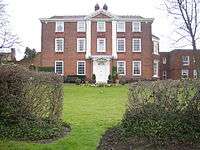Pinner House
Pinner House is a Grade II* listed mansion in Pinner, Middlesex. Its facade was built in 1721, but the rest of the building was constructed at some point earlier that century. It was extended during the 20th century, and has been used as an old people's home since the 1930s.
| Pinner House | |
|---|---|
 Pinner House, 2007 | |
 The location of Pinner House within Greater London | |
| General information | |
| Type | Mansion |
| Address | Church Lane |
| Town or city | Pinner |
| Country | United Kingdom |
| Coordinates | 51.59390°N 0.37814°W |
| Designations | Grade II* listed |
History and description
Pinner House is a brick building decorated with pilasters.[1] The facade was built in 1721, but the rest of the house dates from earlier that century.[2] It was one of several mansions built in Pinner, and is one of only two such buildings to survive, the other being Pinner Hill.[3] The rear of Pinner House was extended in 1977 using materials similar to the original construction. The building is located on Church Lane, near to St John the Baptist church.[1]
The building was designated Grade II* listed on 21 September 1951.[4] A plaque to commemorate the building was placed outside it by Harrow Heritage Trust in 2001.[2]
Occupancy
During the mid-19th century the building was used as a school for children, called Pinner House Academy.[5] It was sold by auction in 1829 with the usage suggested as a family home.[6] It was sold once again in 1911.[7] During the First World War, Pinner House was owned by Mr and Mrs George Neal, whose eldest son was killed in action on the Western Front on 15 June 1915.[8] It was sold again in 1920.[9] It remained as a family home, and was owned by Mr and Mrs George Glanfield at least between 1924 and 1938.[10] Glanfield was a wholesale clothier, and owned the company G. Glanfield and Son, which held the contract for clothing the British Army during World War One.[11] He died in 1938,[12] and the building has been used as an old people's home since that period, but has been sold at least once in that usage.[3][13]
References
Footnotes
- Cherry; Pevsner (1991): p. 286
- "Plaques". Harrow Heritage Trust. Retrieved 21 July 2013.
- Duncan (2010): p. 207
- "Pinner House, Harrow". BritishListedBuildings.co.uk. Retrieved 21 July 2013.
- "Pinner House Academy". The Times (13590). 12 May 1828. p. 2.
- "Mr W. W. Simpson will Sell by Auction". The Times (13993). 15 August 1829. p. 8.
- "The Estate Market". The Times (39602). 3 June 1911. p. 4.
- "Killed in Action". The Times (40889). 24 June 1915. p. 1.
- "The Estate Market". The Times (42425). 1 June 1920. p. 9.
- "Forthcoming Marriages". The Times (43557). 24 January 1924. p. 13.
- "He Clothed Kitchener's Army". The Citizen. 63 (186). British Newspaper Archive. 11 November 1938. p. 8. Retrieved 13 July 2014.
- "Deaths". The Times (48113). 30 September 1938. p. 15.
- "Harrod's Estate Offices". The Times (50850). 27 August 1947. p. 8.
Bibliography
- Cherry, Bridget; Pevsner, Nikolaus (1991). London 3: North West. London: Penguin Books. ISBN 978-0140710489.
- Duncan, Andrew (2010). Andrew Duncan's Favourite London Walks (3rd ed.). London: New Holland. ISBN 978-1847735393.